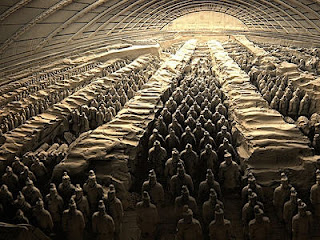Tuesday, February 1, 2011
Land Army earthenware in ancient China
Figures vary in height, size, facial expressions, uniform, hair, and weapons. He was and still is, a testament to the amount of skills and work as well as the pure power, the first emperor had to enable it to undertake such a monumental project.
According to historian Sima Qian, after the death and burial of Qin Shi Huang, the complex funeral which housed the statues was looted, looted and burned by General Xiang Yu approximately five years after the death of the emperor. The fire lasted for approximately three months, but despite the damage caused a large part of the army survived. They have also survived an earthquake and have thus defended their emperor more than 2,000 years.
The site of the terracotta army was found in 1974 in Xian, China, where three local farmers have been dug up wells and came across it by accident. Excavation in 1976 entered new areas filled complex many statues in addition. To date, approximately 8,000 statues were recovered. Discovery has fascinated the world and is considered the eighth wonder of the ancient world.
Monday, January 31, 2011
The informal Chinese clothing
The informal Chinese clothing would include tops and bottoms and one piece robes, which included once or more to the body. A typical set of Hanfu is two or three layered where the first layer of underwear or Zhongyi in white cotton or silk. The second layer is front closed clothes and an optional third layer can Zhao Shan or a coat. This new set of attire could be made 'semi-formal' by adding a pleated skirt (Chang), a cloth Panel belt and a formal hat (Guan) added. Meeting guests or to take or a cultural day it would encourage too 'semi-formal'.
Formal Chinese clothing is reserved for special occasions such as a major victim or other religious activities or special people like emperors and officials. This includes the Xuanduan, a dark robe that the Western black tie and a priest full ceremonial dress called a Fusha matches. A Lanshan was worn as an official or academical dress.
Ancient Chinese clothing and bamboo
No Chinese object is complete without a representation of one or more of the four favorite plants - of bamboo, Chinese plum, chrysanthemum and orchid. Of these, the bamboo in diverse ways is used. Tableware chopsticks and utensils flutes brushes and even hair accessories.
Combs went on bamboo, ivory, jade and other materials improved the ensemble of ancient Chinese clothing for women. Head-dresses in ancient times include hats for women for men and hair pieces. Traditionally, the Chinese carry their hats indoors and outdoors unlike their Western counterparts.
This is mainly because most hats take off and carry around are too impractical.
Mode of ancient China has evolved continually through the various dynasties. For example, the Emperor declared during the Sui dynasty in 500 AD that only rich people could carry colors while poor people in blue or black had to be dressed.
Chinese modern clothing
Chinese clothing is not only visually elegant but also culture symbolizes and communicates its own vitality. Archaeological remains holes fro excavated objects such as bone needles, stone beads and shells with Shantingtung culture you use of ornamentation and sew clearly pointed out in this age. Clothing associated with colors were widespread, red the gravest of color summer green for spring, black for winters and white was represented.
Ancient Chinese clothing preferred darker colors and a fully developed system used by matching, coordination and contrasting colors and shades in apparels. Modern Chinese clothing has combined the old icons luck aesthetics in Chinese modern clothes with modern fashion. A variety of eye of catchy designs for children and teens clothing is designed in modern China is lions, deities and masks of Chinese Opera characters. Modern silhouettes are increasingly using design and appliqué bronzes from old clothes. Prints, weaving, embroidery and motifs from ancient culture blend fabrics and styles with new age, to create modern Chinese clothing.
ANCIENT CHINA - CULTURE AND CLOTHING
China, a fast developing nation today has a story about 5000 years. This 5000 year can be found in older works. Ancient China was indeed one of the most cosmopolitan civilizations. This is evident from the various components that make up its culture. A rich culture was presented in ancient Chinese clothes and dresses.
As a nation it is a conglomerate of various tribes over many years. China under a great Empire was unified in 221 B C. According to history. The Chinese civilization has always been an expanded. In ancient times, the daily routine, consisting of a living with make tasks pottery silk baking and agriculture. In fact most of ancient Chinese clothing for the elite of silk was made! This routine was transformed over the centuries interests in the quest for science and philosophy.
